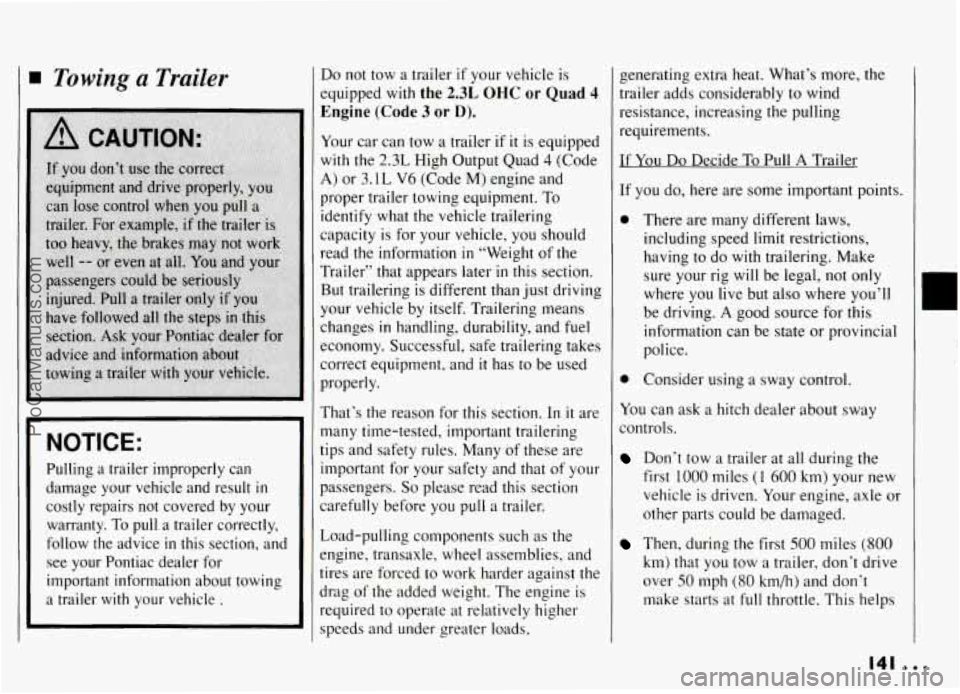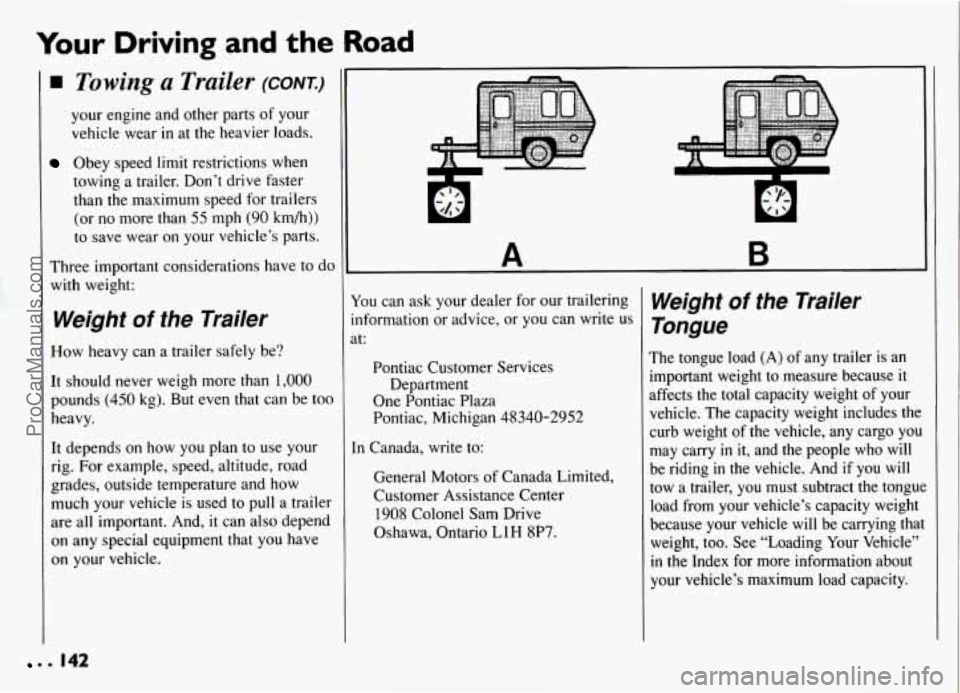1994 PONTIAC GRAND-AM towing capacity
[x] Cancel search: towing capacityPage 142 of 274

Towing a Trailer
NOTICE:
Pulling a trailer improperly can
damage your vehicle and result
in
costly repairs not covered by your
warranty. To pull
a trailer correctly,
follow the advice
in this section, and
see your Pontiac dealer for important information about towing
a trailer
with your vehicle .
Do not tow a trailer if your vehicle is
equipped with the 2.3L OHC or Quad 4
Engine (Code 3 or D).
Your car can tow a trailer if it is equipped
with the
2.3L High Output Quad 4 (Code
A) or 3.1 L V6 (Code M) engine and
proper trailer towing equipment. To
identify what the vehicle trailering
capacity is for your vehicle, you should
read the information
in ‘‘Weight of the
Trailer” that appears later
in this section.
But trailering is different than just driving
your vehicle by itself. Trailering means
changes
in handling, durability, and fuel
economy. Successful, safe trailering takes
correct equipment, and
it has to be used
properly.
That’s the reason for this section. In it are
many time-tested, important trailering
tips and safety rules. Many of these are
important for your safety and that of your
passengers.
So please read this section
carefully before you puli a trailer.
Load-pulling components such as the
mgine, transaxle, wheel assemblies, and
tires are forced
to work harder against the
jrag of the added weight. The engine is
required to operate at relatively higher
speeds and under greater loads,
generating extra heat. What’s more, the
trailer adds considerably to wind
resistance, increasing the pulling
requirements.
If You Do Decide To Pull A Trailer
If you do, here are some important points.
0 There are many different laws,
including speed limit restrictions,
having to do with trailering. Make
sure your rig will be legal, not only
where you live but also where you’ll
be driving.
A good source for this
information can be state or provincial
police.
0 Consider using a sway control.
You can ask a hitch dealer about sway
controls.
Don’t tow a trailer at all during the
first 1000 miles (1 600 km) your new
vehicle is driven. Your engine, axle or
other parts could be damaged.
Then, during the first 500 miles (800
km) that you tow a trailer, don’t drive
over
50 mph (80 km/h) and don’t
make starts
at full throttle. This helps
141
ProCarManuals.com
Page 143 of 274

Your Driving and the Road
Towing a Trailer (CONK)
your engine and other parts of your
vehicle wear
in at the heavier loads.
Obey speed limit restrictions when
towing a trailer. Don’t drive faster
than the maximum speed for trailers
(or no more than
55 mph (90 km/h))
to save wear on your vehicle’s parts.
Three important considerations have to do
with weight:
Weight of the Trailer
How heavy can a trailer safely be?
It should never weigh more than 1,000
pounds (450 kg). But even that can be too
heavy.
It depends on how you plan to use your
rig. For example, speed, altitude, road
grades, outside temperature and how
much your vehicle is used to pull a trailer
are all important. And,
it can also depend
on any special equipment that you have
on your vehicle.
A B
fou can ask your dealer for our trailering
nformation or advice, or you can write
us
It:
Pontiac Customer Services
Department
One Pontiac Plaza
Pontiac, Michigan 48340-2952
[n Canada, write to:
General Motors of Canada Limited,
Customer Assistance Center
1908 Colonel Sam Drive
Oshawa, Ontario L1H 8P7.
Weight of the Trailer
Tongue
The tongue load (A) of any trailer is an
important weight to measure because
it
affects the total capacity weight of your
vehicle. The capacity weight includes the
curb weight of the vehicle, any cargo you
may carry
in it, and the people who will
be riding in the vehicle. And if you will
tow a trailer, you must subtract the tongu
load from your vehicle’s capacity weight
because your vehicle
will be carrying tha
weight, too. See “Loading Your Vehicle”
in the Index for more information about
your vehicle’s maximum load capacity.
. . 142
ProCarManuals.com
Page 266 of 274

Highway Hypnosis ........... 134
.Hill and Mountain ............ 134
In a Foreign Country
.......... 172
In the Rain
.................. 13C
Logg Distance ............... 132
Loss of Control
.............. 128
On Curves
.................. 125
Passing
.................... 127
Skidding
................... 128
Through Deep Standing Water
... 58
Winter Driving .............. 136
With a Trailer
............... 144
Driving.on Snow or Ice .......... 136
Drunken Driving
............... 120
Easy-Entry Seat ................ 11
Electrical Equipment. Adding
. 107. 2 1 1
Emergencies. Braking .. .. ........ 125
Emergencies on the Road
......... 147
Emergencies. Steering
in ......... 126
Emergency Starting
.. i .......... 148
Emergency Towing
............. 152
Engine Coolant Heater (Engine Block Heater)
....... : ..... 58. 182
Engine Coolant Temperature
Warning Light ................. 94
Engine Identification
............ 2 11
Engine Oil
.................... 179
Additives ................... 182
Checking
& Adding .......... 179
Disposing of Used Oil
........ 182
Engine Coolant (see “Coolant”) .... 188
Energy Conserving ........... 18 I
Filter .................. 182. 22C
Kind of Oil to Use
............ 18C
Pressure- Gage ................ 9f
Warning Light
................ 95
When to Change ............. 182
Engine Overheating ............. 156
Engine Specifications
............ 2 19
Engine. Starting
................. 56
Automatic Transaxle ........... 56
Manual Transaxle ............. 56
2.3L Quad 4 Engine
........... 56
3.lL V6 Engine ............... 57
Ethanol in Gasoline ......... 17 1. 172
Exhaust
Dangerous Gas in
......... 70. 138
Pirking with the Engine
Running ................ 67. 69
Expectant Mothers. Use of Safety
Belts ......................... 26
Expressway Driving
............. 132
Extender. Safety Belt
............. 42
Exterior Appearance (see “Appearance
Care”) ....................... 204
Fabric Cleaning (see “Appearance
Care”) ...................... 204
Filling the Fuel Tank
........ 174. 2 16
Filter. Oil
................ 182. 220
Finish Damage
................. 209
Flashers. Hazard Warning
........ 148
Flat Tire
...................... 161
Flooded Engine ................. 57
Flow-Through Ventilation System . . 105
Fluid
‘Brake ...................... 192
Capacities
.................. 215
Hydraulic Clutch
............. 187
Power Steering
.......... 190. 216
Transaxle
Automatic ........... 184. 215
Manual
.............. 186. 215
Windshield Washer
........... 191
Fluids
& Lubricants ............. 238
Fog Lights
................. 79. 196
Freeway Driving
............... 132
French Language Manual
.......... 2
Fuel
......................... 171
Alcohol
in Fuel .......... 17 1. 172
Capacity
................... 216
Exhaust Warnings
......... ..70. 138
Filling Your Tank
......... 1 .. 174
Fuels
with Alcohol ....... !7 1. 172
Gage
........................ 93
In Foreign Countries .......... 173
Remote Fuel Filler Door
........ 53
Requirements
............... 171
Fuse Usage Chart ............... 213
Fuses
& Circuit Breakers ......... 212
Gages
Coolant Temperature .......... 94
Fuel ........................ 93
Oil Pressure .................. 96
265
E
ProCarManuals.com